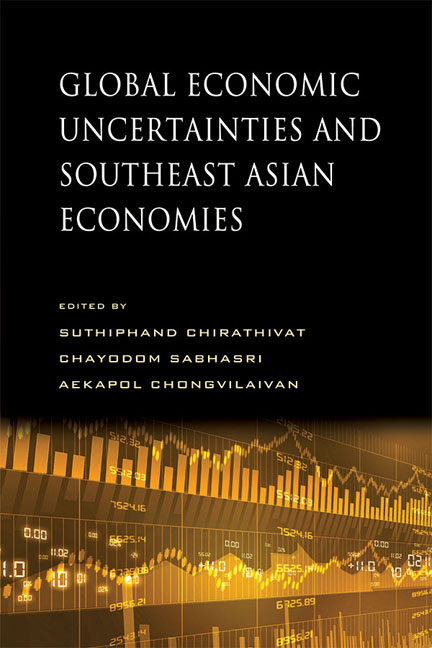Book contents
- Frontmatter
- Contents
- Preface
- Contributors
- 1 Challenges Facing a Globally Connected ASEAN
- 2 Fragile Balance of Payment in Indonesia under Global Economic Uncertainties
- 3 Malaysia in the Midst of Global Economic Uncertainties
- 4 Singapore: Reinventing Itself amid Global Economic Uncertainties
- 5 Thailand: Dependency or Diversification?
- 6 Vietnam's Economic Experience since WTO Accession
- 7 Global Economic Imbalances and Reform Policy: Evidence from Asian Economies
- 8 Foreign Exchange Rate Adjustment Policies in Asia
- 9 Monetary and Financial Architectures for ASEAN+
- 10 Global Uncertainties: Implications for the ASEAN Community
- Index
5 - Thailand: Dependency or Diversification?
Published online by Cambridge University Press: 22 July 2017
- Frontmatter
- Contents
- Preface
- Contributors
- 1 Challenges Facing a Globally Connected ASEAN
- 2 Fragile Balance of Payment in Indonesia under Global Economic Uncertainties
- 3 Malaysia in the Midst of Global Economic Uncertainties
- 4 Singapore: Reinventing Itself amid Global Economic Uncertainties
- 5 Thailand: Dependency or Diversification?
- 6 Vietnam's Economic Experience since WTO Accession
- 7 Global Economic Imbalances and Reform Policy: Evidence from Asian Economies
- 8 Foreign Exchange Rate Adjustment Policies in Asia
- 9 Monetary and Financial Architectures for ASEAN+
- 10 Global Uncertainties: Implications for the ASEAN Community
- Index
Summary
INTRODUCTION
Over the past two decades, Thailand, along with other Southeast Asian countries, has twice experienced severe economic downturns. The first, the infamous Asian financial crisis of 1997, originated in Thailand itself and then spread to other Southeast Asian countries. A combination of moral hazard in the financial sector, asset price bubbles, and mismanaged capital flow policy led to the country losing its competitiveness and this later prompted speculative attacks on the Thai baht; during 1998 the contraction of the Thai economy reached double-digit territory (–10.51 per cent) for the first time in its history. However, a heavily depreciated currency and explosive growth in exports helped the economy to recover quickly in the following years. Since then, the financial sector has been strengthened through the implementation of international-standard regulations as well as by close monitoring by the monetary authorities. Stabilization policy also aims to balance long-term growth and short-term price stability. In fact, Thai exporters enjoyed low inflation (averaging 2.5 per cent per year) and stable foreign exchange rates during the years 2000 to 2008, and international trade has thus been an important growth engine for the Thai economy over the past decade.
In late 2008 Thailand experienced a second episode of economic turmoil, but this time the shocks came from external economies. The subprime crisis, led by a real estate bubble and unregulated growth in financial derivatives in the United States, precipitated a global economic meltdown. Because Thailand has been dependent on external demand since the currency crisis of 1997–98, the country suffered greatly. Although Thailand has been actively promoting free trade agreements (FTAs) with regional economies, including the ASEAN Free Trade Agreement (AFTA), the Thailand-Australia FTA, and the ASEAN-China Free Trade Agreement (ACFTA) in order to diversify its trading partners and export destinations, in 2009 the subprime crisis immediately reduced Thailand's export growth to negative territory. This shows that Thailand is still vulnerable to fluctuations in the business cycle in the advanced economies, and this weakness has motivated policymakers to revisit their export-led growth policy.
The literature indicates that there are three possible transmission channels for financial crises. These are the financial channel (including both liquidity crunches and capital market slumps), the international trade channel, and contagion. Some research suggests that trade linkage between countries is one of the most important transmission channels for crises.
- Type
- Chapter
- Information
- Global Economic Uncertainties and Southeast Asian Economies , pp. 106 - 122Publisher: ISEAS–Yusof Ishak InstitutePrint publication year: 2015



